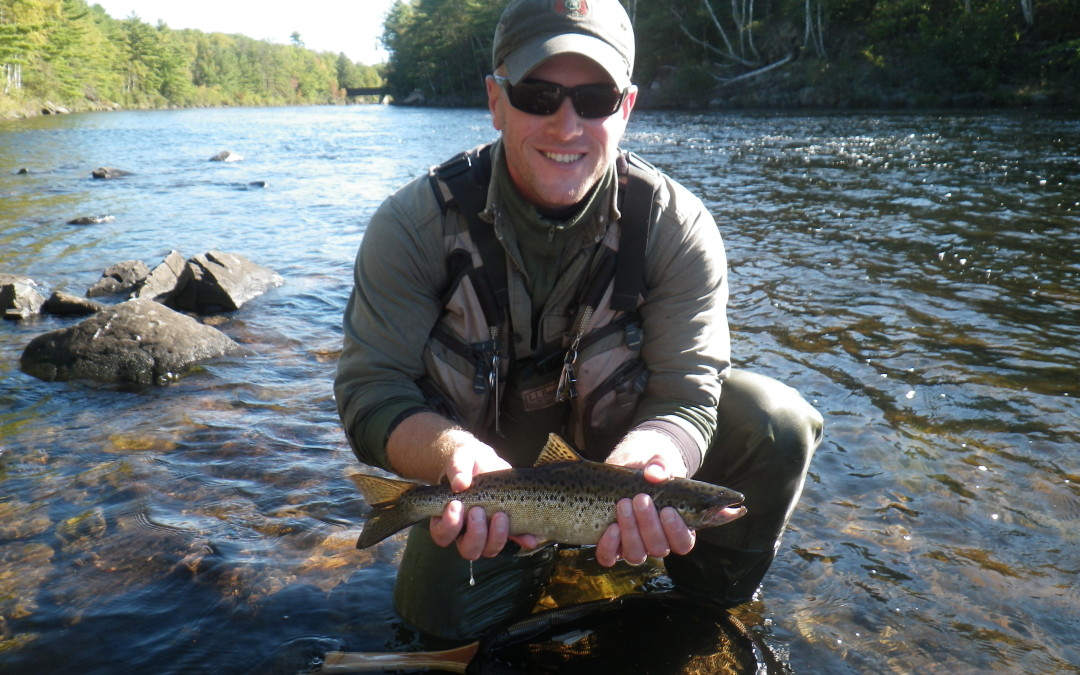After leaving the Roach River we were on the West Branch of the Penobscot below North Twin Dam the next day. As Jeff and I approached the river, salmon were taking caddis from the surface with splashy rises, which only increased our excitement. It seems like this stretch of river is always full of life and action. Even when the fish are not cooperating there are very reliable insect hatches that come off very thick. Even in heavy current these salmon will rise aggressively for dry flies, but many times they will miss often before they connect with your offering. Nothing is more exciting than having a salmon rise multiple times to your fly even if you do not catch that fish. Caddis are very prevalent here and the key to fishing any caddis pattern is completely understanding how these insects behave. As the caddis nymphs make their ascension to the surface they do so very quickly and the fish react accordingly. Allow your nymph pattern to bounce along the bottom, but stop your rod at certain points during your drift and allow the current to swing your fly quickly to the surface. Hold on as many times as a fish will take your fly with reckless abandonment. As adults, caddis are often seen daping the surface of the water in rapid succession. They are very strong and are not helpless like most mayflies that just float down the current. It is ok to skate, or twitch your dry fly against the current to imitate the adults. The Goddard caddis has an amazing floating quality that is my go-to fly in these types of situations.
Even with this surface activity Jeff and I both stayed with our streamers and full sinking lines. The salmon in this river were in a spawning mode and we wanted to take advantage with our attractor streamers. This river is much different than the Roach River as the salmon are widely dispersed throughout and any section holds good fish. There is one section in particular that I will not take any client to as the path to this section is not easily traversed and one missed step can put you over your head very quickly. As Maine Guides, we need to keep our clients out of the way of harm instead of marching them toward it. This section always produces for me and a few years ago I had one salmon that always eluded me. I would either hook and loose him or be ready to net him and he would come off the hook. It wasn’t until October of that year that I finally landed him and for his elusiveness he won his freedom again. Now you may ask how did I know it was the same fish? Mostly it is an educated guess as this fish came from the same run and reacted to the same presentations every time. It also looked the same every time, but it could very well have been a different fish. It just sounds better that it was the same fish.
Once I got to my spot it wasn’t long before I had the first salmon to net. Swinging a streamer through the fast water produces for me here every time. In many spots the water is not very deep and you can see the effects of the large boulders underneath the water on the surface of the river. With all of the conflicting currents it is just easier to swing a streamer. Just allow the streamer to work on the swing which is more effective than an active retrieve. The only dry fly that I would use in this scenario is a caddis and skating the aforementioned Goddard Caddis along the current is one of my favorite methods here. I still use a full sinking line here as it cuts through the current and keeps my streamer tracking true. This is not the only really productive section as Jeff was working his streamers off the shelf that has built up on the upper section and was coming up with some very nice salmon. Fish can be taken using various different methods from this shelf. A double or triple nymph rig is especially deadly here as well. Just be careful not to wade too close to the edge as many times really good salmon hold right along the edge. Case in point is the picture at the top of this report. He came from this very edge on a Grey Ghost Special.
The next day I was flying solo and found myself plying the waters of Millinocket Stream below Millinocket Lake. For those of you that remember, I guided my mother-in-law here earlier in the year for a couple of days. There are a multitude of species to be had here, but at this time of the year I again found myself chasing after the native salmon that inhabit this stream. I always find the most solitude when I am on the water as the sun comes up. The possibilities of the day are endless and I find a great deal of calmness within myself. I try really hard to slow down and enjoy the moment, but I am always rushing to get my fly in the water. Never lose that enthusiasm for enjoying the outdoors as you may look back someday and wish to have those days back. The one main point that I will stress is to observe what is going on with the water. Even though I start with a streamer most of the time I am very quick to change to another method or fly if I see something specific in or on the water. I have separate reels loaded with floating and sinking lines so a change is very quick. I would encourage you to at least have a separate spool for your reel loaded with different line to be more flexible. If the fish are taking insects on or around the surface I can quickly change to a floating presentation. On this day I did not have to change from a streamer as the salmon were keying on my baitfish imitations all morning long.
One of the major reasons for coming to this stream on this day is that for years I had wanted to explore different sections of this river. Today I worked a few miles downriver in search of some better water. Even though I did not find the numbers of fish that I wanted it did not mean that this endeavor was a failure. I did find some beautiful scenery and some pools that I will spend countless hours on come spring. To truly understand a body of water one must fish it many times and cover a lot of water. What goes unsaid is most guides put in countless hours fishing without catching fish while looking for new water. Taking countless notes and fishing at different times of the year help build a resume of waters that a guide can pull from for our clients. By looking at patterns I can confidently say that the fish should be there at that time of the year. However, as we all know, weather and fishing can be unpredictable and guides cannot control how each will pan out. We will put our clients in the best position to catch fish and I know personally that I will try everything to get my clients into fish. All I ask, and I know most guides will say the same thing, is to come ready to learn and keep an open mind. Many clients may have a preference for how they want to fish and being up-front with your guide will prevent any disappointment. We all want the same result. Sometimes how we get there is the most important lesson of the day.














And a successful trip it was. Especially since I really didn’t care what I caught.LOL